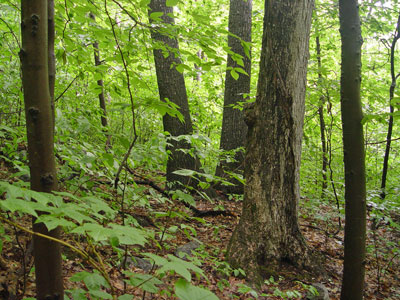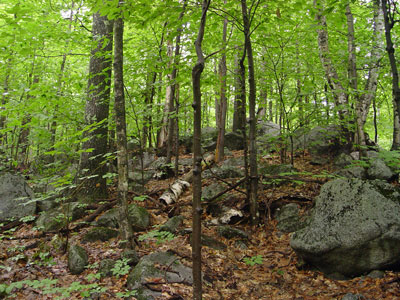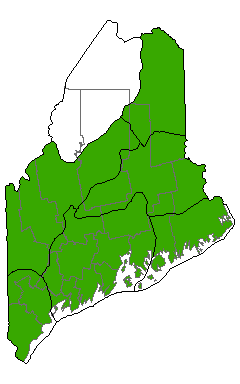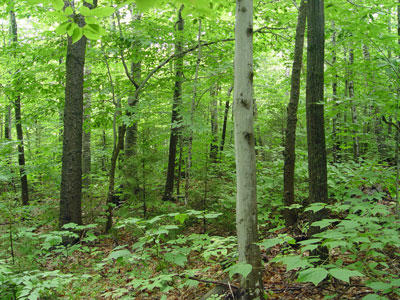DACF Home → Bureaus & Programs → Maine Natural Areas Program → Communities, Plants, and Animals → Natural Community Fact Sheets → Oak - Northern Hardwoods Forest
Printer Friendly Fact Sheet - 920 KB pdf (Get a free copy of Adobe Acrobat Reader)
Oak - Northern Hardwoods Forest
Scientific Name: Red Oak - Northern Hardwoods - White Pine Forest; State Rank: S5

- Community Description
- Soil and Site Characteristics
- Diagnostics
- Similar Types
- Conservation, Wildlife and Management Considerations
- Distribution
- Characteristic Plants
- Associated Rare Plants
- Associated Rare Animals
- Examples on Conservation Lands You Can Visit
Community Description: This is a mixed upland forest type with red oak and northern hardwoods in the canopy. Some stands are almost entirely deciduous (typically oak - beech), while others are mixed with white pine, red spruce, hemlock, or (especially along the coast) northern white cedar. Red oak comprises up to 25-85% cover; beech is less than half that of red oak. Large red oak trees are prominent. Red maple is frequent. The shrub/sapling layer is usually sparse (<25%, but occasionally up to 50% cover). The herb layer is likewise spotty (usually <10% cover, sometimes 20-50% cover), with very few dwarf shrubs aside from lowbush blueberry, and with typical forest herbs and tree regeneration (red maple, red oak, white pine, beech). Few bryoids are found on the leaf litter covered forest floor. Back to top.
Soil and Site Characteristics: Sites occur on gently to somewhat steeply sloping (15-35%) mid- and lower slopes, occasionally upper slopes, but usually not highly exposed sites. Known sites are at low elevations (<1200’) on moderately well drained mineral soils, often rocky but not extremely shallow (typically 25-50 cm) and loamy, with pH 5.0-5.4. Back to top.

Diagnostics: These are closed canopy forests in which red oak and at least one northern hardwood species (beech, sugar maple, or, infrequently, yellow birch) dominate the canopy. In southern Maine, Maple-leaved viburnum is an indicator shrub. Back to top.
Similar Types: Oak - Pine Forests, the most similar type, generally lack sugar maple, white ash, and ironwood. Northern Hardwoods Forests have only minor amounts of red oak, and generally are strongly deciduous (>75%) rather than mixed. Spruce - Northern Hardwoods Forests lack red oak. Back to top.
Conservation, Wildlife and Management Considerations: Most sites in Maine are on lands with a long settlement history, and have apparently been timbered, pastured, or burned in the past. Several sites occur on public lands but are not necessarily designated as areas to be set aside from timber harvest. Small and isolated protected stands (on the order of 25 acres or less) may not be viable in the long run; though larger stands, or naturally small stands protected within a managed forest matrix, could be viable.
The community provides nesting habitat for a large number of passerine bird species, such as black-throated blue warbler, black-throated green warbler, scarlet tanager, and ovenbird. Mature stands offer excellent potential sites for cavity nesters. The state rare red-winged sallow moth uses red oak as one of its host plants and may be found in this community. The globally uncommon early hairstreak butterfly uses beech as its larval host plant. Back to top.
Distribution: Primarily the Laurentian Mixed Forest Province (except for the far northern portion) and southern portion of the New England - Adirondack Province, extending eastward and westward from Maine. Landscape Pattern: Matrix-forming in southern Maine, though currently many occurrences exist as large patches due to fragmentation. Back to top.


Characteristic Plants: These plants are frequently found in this community type. Those with an asterisk are often diagnostic of this community.
- Canopy
- American beech
- White pine
- Paper birch
- Red maple
- Red oak*
- Striped maple
- Sugar maple*
- Sapling/shrub
- Maple-leaved viburnum
- Striped maple
- White pine
- Sugar maple
- Beech
- Herb
- Bracken fern
- Canada mayflower
- Starflower
- Wild sarsaparilla
- Wild-oats
- Early hairstreak
- Red-winged sallow
- Whip-poor-will
Examples on Conservation Lands You Can Visit
| Example | County |
|---|---|
| Albany Mountain, White Mountain National Forest | Oxford Co. |
| Alonzo Garcelon Wildlife Management Area | Kennebec Co. |
| Center Hill, Mount Blue State Park | Franklin Co. |
| Mt Megunticook, Camden Hills State Park | Knox Co. |
| Patte Hill, White Mountain National Forest | Oxford Co. |
| Sebago Lake State Park | Cumberland Co. |
